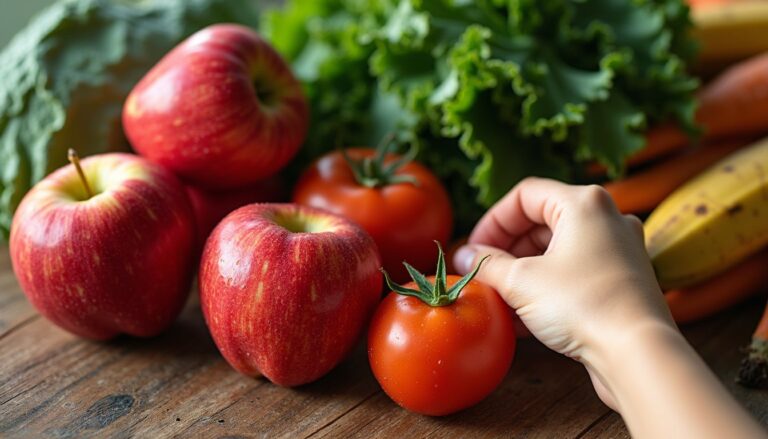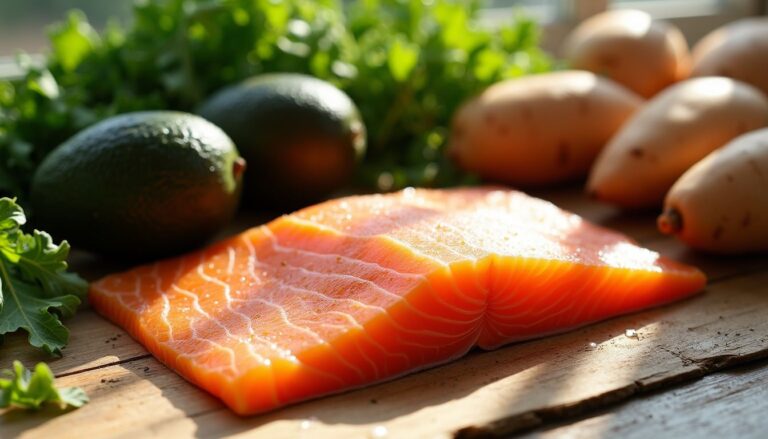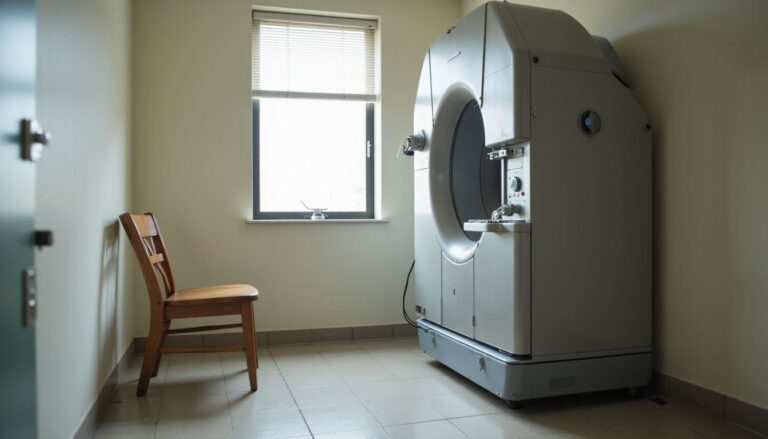7-Day Mediterranean Diet Meal Plan For Weight Loss: The Best Diet Plan To Lose Weight
Our Nutrition Assistant AI Suite will transform your body. You will lose fat, get toned, and build muscle. Gain confidence and optimal health.
You may feel stuck trying to lose weight and want an eating plan that is realistic. The Mediterranean diet is linked to lower heart disease risk, easier weight management, and better health.
This guide shows how a simple 7-day meal plan can help you lose weight safely with tasty, filling food. Get clear steps, balanced choices, and flexible options that fit busy days. Start your week of healthy eating today; practical tips are ahead.
Key Takeaways
- The Mediterranean diet centers on vegetables, fruits, whole grains, beans, nuts, fish at least three times weekly, and extra virgin olive oil for heart health.
- Large studies report up to a 30 percent drop in major heart events and up to a 35 percent lower risk of type 2 diabetes with this pattern of eating [PREDIMED, NEJM 2013; ADA 2019 guidance].
- This 7-day plan favors lean protein like fish or skinless poultry, limits red meat to once a week, and uses portions instead of strict calorie counting.
- High fiber foods and healthy fats increase fullness, which supports steady weight loss of about 1 to 2 pounds per week.
- Daily movement for at least 30 minutes and limiting sweets, added sugars, processed meats, refined grains, and sugary drinks help results last.

Understanding the Mediterranean Diet

The Mediterranean diet is a balanced diet built on nutrient-rich foods like vegetables, whole grains, healthy fats, and lean protein. It supports a healthy weight and heart health without strict rules.
What is the Mediterranean Diet?
This pattern reflects foods eaten in countries around the Mediterranean Sea in the mid-20th century. You focus on plants first: vegetables, fruits, whole grains such as oats and brown rice, legumes like chickpeas and beans, and nuts such as almonds and walnuts.
Extra virgin olive oil replaces butter and other saturated fats. Fish that are rich in omega-3 fatty acids, which are heart-friendly fats, appear several times per week. Cheese and yogurt come in modest amounts, and red meat is rare. Some adults choose to drink wine in moderation, up to one glass daily for women or two for men.
Doctors support this diet because research links it with lower coronary artery disease risk, better blood sugar control, and successful weight management.
Traditional food habits often turn into sustainable routines that help you maintain a healthy weight.
Next, you will see the core principles that shape everyday meals on this eating plan.
What are the main principles of the Mediterranean Diet?
Fill most of your plate with vegetables, fruits, beans, lentils, nuts, and whole grains. Choose whole-wheat bread or brown rice over refined carbohydrates to support a healthy diet and lose weight safely.
Use extra virgin olive oil as your main fat, about 1 to 4 tablespoons per day. Keep red meat to once a week or skip it. When you eat it, choose about 3 ounces of lean cuts. Enjoy fish at least three times weekly, with portions around 3 to 4 ounces.
Include starchy vegetables like sweet potatoes and fiber-rich legumes such as chickpeas or black beans at least three times per week. Keep dairy moderate, such as one cup of milk or yogurt daily, or up to 1.5 ounces of cheese.
Limit sweets, sugary drinks, processed foods, and commercial baked goods. If you want dessert, make simple fruit-based treats at home up to three times per week.
Many people find this approach meets calorie needs while offering fiber and antioxidants. It can also help people with high blood pressure or diabetes, since lower saturated fat and higher fiber improve digestion and cardiovascular risk factors.
Next, see how these principles support weight loss and a healthier heart.
How Does the Mediterranean Diet Help with Weight Loss?
The Mediterranean diet offers a healthy way to eat that supports weight loss goals. It features nourishing foods that are low in calories yet high in antioxidants and dietary fiber.
How does it promote sustainable weight loss?
This plan helps you build steady habits instead of quick fixes. Large portions of vegetables and fruits add volume for few calories, which keeps you full longer.
For example, trade a heavy breakfast sandwich for whole grain toast with cottage cheese and tomato. You raise fiber and lower calories without losing taste. Pair the diet with daily activity for at least 30 minutes. A realistic pace is 1 to 2 pounds per week.
You do not need to count every calorie. Practice simple portion checks and mindful choices. Many dietitians encourage small daily shifts, like walking after dinner or choosing hummus instead of mayonnaise. These steps make long-term success easier.
How does it improve heart health?
This way of eating supports your heart while you work on weight. Extra virgin olive oil, used daily at 1 to 4 tablespoons, supplies monounsaturated fats and antioxidants that lower LDL cholesterol, often called bad cholesterol.
Limiting saturated and trans fats reduces the buildup of plaque in arteries. Fish rich in omega-3s, such as salmon or tuna, helps lower cardiovascular risk. Colorful produce, legumes, and leafy greens add fiber and antioxidants that calm inflammation.
Some adults enjoy moderate wine with meals. That is up to one glass daily for women or two for men. Together, these habits help manage blood pressure and cholesterol.
How does it reduce the risk of chronic diseases?
This eating plan lowers chronic disease risk because it emphasizes minimally processed foods, healthy fats, and plenty of plants. Studies show up to a 30 percent reduction in heart events and up to a 35 percent lower chance of type 2 diabetes with this diet pattern.
Whole grains, beans, and vegetables help steady blood sugar and support gut health. Lower sodium and fewer fatty meats support normal blood pressure. Research also links this pattern with slower cognitive decline as you age.
The focus on fiber and lean proteins reduces inflammation across the body. Choosing fresh salads and roasted vegetables over fried or canned options supports long-term health.
How does it encourage balanced and nutritious eating?
You aim for at least three servings of fruit and three servings of vegetables every day. Whole grains and starchy vegetables, like corn or sweet potatoes, provide 3 to 6 servings for energy.
Nuts a few times per week add healthy fats. Cheese and thick yogurt supply protein in moderate amounts. Sweets are limited, so fruit or plain yogurt often becomes dessert. This helps you control calories per day without feeling deprived.
These habits are simple to keep over time. Next, build a 7-day Mediterranean diet meal plan that fits your taste and calorie needs.
How to Create a 7-Day Mediterranean Diet Meal Plan
To plan meals for a 7-day Mediterranean diet, focus on healthy foods and clear choices that support your weight loss plan. The outline below keeps it simple.
What key elements should be included?
A strong 7-day meal plan balances nutrients, keeps meals interesting, and fits daily life. Use this checklist as your base.
- Include at least 3 servings of fresh fruit and 3 servings of fresh vegetables every day for vitamins and fiber.
- Build each meal around lean proteins such as fish, skinless chicken, or canned black beans to support muscle and fullness.
- Add whole grains or starchy vegetables like brown rice, corn, or roasted sweet potatoes 3 to 6 times daily for steady energy.
- Use extra virgin olive oil as your main fat. Aim for 1 to 4 tablespoons per day to support heart health.
- Plan at least 3 servings each week of fish and legumes for omega-3s and plant protein.
- Limit red meat to one serving a week or less. Choose plant-forward meals most days.
- Pick smart snacks, such as unsalted nuts, plain Greek yogurt, chopped vegetables, or fresh fruit to tame cravings.
- Keep sweets to fruit-forward, homemade treats up to three times per week, and skip heavily processed desserts.
- Manage dairy with modest portions, such as plain yogurt or a small amount of feta. If you monitor cholesterol, limit egg yolks.
- Drink water throughout the day to support digestion, and avoid sugary beverages.
With these blocks in place, building a grocery list gets easier. Next, see which foods to avoid to support weight loss.
What foods should be avoided?
Knowing what to skip is just as useful as knowing what to include. These items work against your weight loss plan and heart health.
- Commercial baked goods like donuts, pastries, cookies, and cakes. They often contain added sugar, trans fats, and sodium.
- Processed meats such as bacon, sausage, hot dogs, ham, and salami. They add excess sodium and unhealthy fats.
- Sugary drinks including soda, sweet teas, fruit punches, and energy drinks. They add calories without nutrients.
- Refined grains such as white bread, regular pasta, white rice, and many convenience buns. They lack fiber.
- Heavy butter or cream-based sauces and soups. Swap for olive oil dressings or vegetable-based soups.
- Store-bought sweets with high sugar and fat. Choose simple fruit desserts at home instead.
- Red meat more than once weekly. Focus on fish and poultry as default choices.
- Processed snack foods, like chips and many crackers. Choose nuts or berries for a better bite.
- Fast food meals that are rich in trans fats and sodium.
- Alcohol other than wine for those who already drink it. Keep wine moderate, no more than a glass a day for women or two for men.
When I swapped deli meats for grilled chicken salads with spinach and bell pepper, my afternoon energy improved within a week.
Sample 7-Day Mediterranean Diet Meal Plan
Use this sample 7-day plan as a flexible guide. Cooking methods like roasting, grilling, steaming, and baking help you keep flavor high and calories reasonable.
Day 1:
Start with 3/4 cup bran flakes, a banana, and one cup fat-free milk. This combination adds fiber and potassium with a light calorie load.
For lunch, fill a mini whole-wheat pita with three ounces turkey breast, half a roasted pepper, one teaspoon light mayonnaise with a little mustard, and crisp lettuce. That gives you lean protein and vegetables in a quick format.
Dinner: enjoy four ounces baked or grilled flounder, one cup cooked couscous, and steamed broccoli. If you want dessert, have a single-serve ice cream to keep portions steady.
Meals on Day 1 use nutrient-dense foods that align with your weight loss goals without losing flavor.
What can I eat for breakfast on Day 1?
Have 3/4 cup bran flakes with one banana and one cup fat-free milk. You get whole grains, fruit, and protein within a modest calorie target.
Prefer variety? Try whole-grain toast with one tablespoon avocado, a poached egg, and one cup mixed berries. Greek yogurt with sliced berries or warm steel-cut oats also fit well.
Starting the day with filling fiber makes it easier to focus on your morning routine and exercise plan.
What is a healthy lunch option for Day 1?
Choose a mini whole-wheat pita stuffed with 3 ounces turkey, half a roasted pepper, one teaspoon light mayonnaise with mustard, and lettuce. Add one part-skim mozzarella string cheese and two kiwis for extra protein and vitamin C.
Or build a salad with 2 cups greens, 3 ounces grilled chicken, a quarter cup feta, olives, a vinegar-based dressing, and one crisp apple on the side. Both options keep portions in check and deliver fiber and lean protein.
On busier days, add berries or an orange if you feel hungrier after activity.
What should I have for dinner on Day 1?
Enjoy 4 ounces flounder, one cup cooked couscous, and one cup steamed broccoli. Sauté the fish in a teaspoon of olive oil to add healthy fats while keeping saturated fat low.
Keep portions steady. If you want something sweet, choose a small single-serve ice cream. Prefer tilapia? Bake it and pair with brown rice instead of couscous.
Next, explore Day 2 ideas that maintain variety and balance.
Day 2:
Breakfast: blend one cup frozen berries, half a banana, and eight ounces low-fat or fat-free milk for a smoothie. Add one or two hard-boiled eggs for protein.
Lunch: have a cup of vegetable soup with a veggie burger on whole grain toast or an English muffin, plus a cup of grapes.
Dinner: barbecue-style lean cutlets with citrus slaw, about 265 calories per serving. Sauté spinach with garlic and tomatoes in olive oil, and add half a baked potato.
Each plate offers lean proteins, vegetables, healthy fats, and controlled portions that help you stay on track.
What is a nutritious breakfast for Day 2?
Blend 1 cup frozen berries with half a banana and 8 ounces low-fat milk. Add 1 or 2 hard-boiled eggs for protein that keeps you full.
This combo gives fiber from fruit and calcium from milk. Eggs offer high-quality protein that supports muscle health. Whole-grain toast with an egg is another quick option. An orange on the side boosts vitamin C.
Both choices are easy to prepare before school or work and keep energy steady until lunch.
What lunch fits the Mediterranean Diet on Day 2?
Enjoy one cup vegetable soup and a veggie burger on whole grain toast or an English muffin. Add one cup of grapes for natural sweetness. You get plant-based protein, fiber, complex carbs, and healthy fats in line with Mediterranean principles.
Another option is a whole-wheat wrap with three ounces turkey, lettuce, tomato, hummus, and carrot sticks. These meals keep portions reasonable while packing vitamins and minerals.
Simple lunches like these support steady energy through the afternoon and align with evidence-based nutrition.
What dinner options are suitable for Day 2?
Prepare barbecue beef or pork cutlets with citrus slaw for a balanced dinner at about 265 calories per serving. Sauté spinach with garlic and tomatoes in olive oil. Add half a baked potato for complex carbs.
Prefer seafood? Grill four ounces of shrimp and serve with one cup quinoa and roasted asparagus. Both choices deliver lean protein, vegetables, and healthy fats that support weight control.
Leftover brown rice can stand in for quinoa on busy nights, which saves time without losing nutrition.
Day 3:
Breakfast: cook 1/2 cup quick oats in low-fat or unsweetened soy milk. Add half an apple, one teaspoon honey, and cinnamon. This bowl offers steady energy and fiber.
Lunch: make chicken salad with four ounces cooked chicken breast, grapes, celery, sliced almonds, a spoon of mayonnaise, and plain Greek yogurt. Serve on lettuce with one slice of multigrain toast. Add orange slices or fresh berries.
Dinner: steam four ounces shrimp. Bake a potato and top with salsa and Greek yogurt instead of sour cream. Steam three cups spinach on the side. For dessert, pick one ounce of chocolate or a 100 to 150 calorie ice cream bar.
These quick recipes take under thirty minutes and fit the Mediterranean style well.
What breakfast choices are good for Day 3?
Choose quick oats cooked with low-fat or unsweetened soy milk. Add half an apple, a teaspoon honey, and cinnamon. This provides fiber and natural sweetness.
Or cook one cup whole oats and mix in half a banana with a tablespoon flaxseeds. Fruit adds vitamins while keeping the meal simple and filling.
Both options work well within a modest calorie day and highlight whole grains with fruit on the side.
What lunch meals follow the Mediterranean Diet on Day 3?
Enjoy chicken salad made with 4 ounces cooked chicken, diced grapes, sliced almonds, chopped celery, and a light mix of mayonnaise and Greek yogurt. Serve over lettuce with a slice of multigrain toast.
Want a plant-based option? Toss half a cup chickpeas with cucumber, bell pepper, two tablespoons tahini, and mixed greens. Both choices offer fiber, healthy fats, and vitamin C from fresh produce.
Portion control keeps you satisfied without feeling heavy.
What are dinner ideas for Day 3?
Serve 4 ounces steamed shrimp with a baked potato topped with 3 tablespoons salsa and 1 tablespoon plain Greek yogurt. Add three cups steamed spinach for extra fiber and iron.
For dessert, allow either 1 ounce dark chocolate or a 100 to 150 calorie ice cream bar. Prefer a plant-based meal? Stir-fry four ounces tofu with mixed vegetables and serve over half a cup brown rice.
These dinners balance lean protein, healthy fats, and produce to support weight loss goals. Continue to Day 4.
Day 4:
Breakfast: have one cup plain or low-sugar Greek yogurt topped with one cup berries. Build a quick parfait if you like a bit of crunch with whole-grain toast on the side.
Lunch: pair one cup tomato soup with a mini whole-wheat pita stuffed with three ounces roast beef, horseradish, mustard, tomato, and lettuce. Add two cups raw veggies, such as carrots or bell peppers, with a quarter-cup hummus.
Dinner: poach four ounces salmon and serve over a light coleslaw made from one and one-fourth cups cabbage mix, two scallions, one tablespoon rice vinegar, and 1.5 teaspoons olive oil. Add one cup cooked quinoa.
Each dish is quick to prepare and keeps you full through the evening.
What is a healthy breakfast for Day 4?
Eat one cup plain or low-sugar Greek yogurt plus one cup berries. This gives you protein, probiotics, and fiber with minimal added sugar.
Or layer six ounces Greek yogurt with one-third cup granola and berries for a simple parfait. These choices help you stay full through the morning and align with weight loss goals.
Enjoy an orange on the side if you want extra vitamin C.
What Mediterranean lunch can I have on Day 4?
Have one cup tomato soup and a mini whole-wheat pita with 3 ounces roast beef, lettuce, tomato, horseradish, and mustard. Pack 2 cups raw veggies, like carrots or bell peppers, and dip them in 1/4 cup hummus.
This meal includes lean protein, fiber-rich vegetables, and whole grains that support steady energy.
It is filling without weighing you down for the rest of the day.
What dinner fits Day 4 of the plan?
Prepare 4 ounces poached salmon for omega-3 fats and high-quality protein. Add crunchy coleslaw made with cabbage mix, scallions, rice vinegar, and olive oil. Serve with one cup quinoa as your whole grain.
Enjoy orange slices on the side for natural sweetness and vitamin C. Olive oil adds healthy fats without too many calories.
These foods are easy to prep ahead so evenings stay simple.
Day 5:
Breakfast: a bowl of whole-grain cereal like Cheerios with fresh berries, sliced almonds, and plain Greek yogurt. You get protein, healthy fats, and fiber for a strong start.
Lunch: make mushroom quesadillas on whole grain tortillas. Serve with cucumber spears and cottage cheese or Greek yogurt topped with clementine segments.
Dinner: balsamic-glazed pork tenderloin with roasted butternut squash. Extra virgin olive oil adds flavor that fits the Mediterranean diet focus on heart health.
Smaller portions help you stay aligned with weight loss targets.
What should I eat for breakfast on Day 5?
Place 1 cup Cheerios in a bowl. Top with 1/2 cup fresh berries and 1 tablespoon slivered almonds. Add 6 ounces plain Greek yogurt on the side, or mix it in for protein and calcium.
Whole-grain cereal supports heart health. Berries add fiber and vitamins. Almonds supply vitamin E and help with fullness. Greek yogurt offers probiotics that support digestion.
This mix aligns with Mediterranean principles without added sugars.
What lunch options are best on Day 5?
Mushroom quesadillas on whole-wheat tortillas with cucumber spears make a balanced lunch. Preparation is quick, and the meal is light in calories and rich in fiber.
Pair your quesadillas with cottage cheese or plain Greek yogurt topped with clementine segments for extra protein and vitamins. Fresh vegetables and fruit add volume without many calories.
For a snack later, add a handful of berries for antioxidants and flavor.
What dinner meals suit Day 5?
Choose balsamic-glazed pork tenderloin for lean protein. Add roasted butternut squash for fiber and vitamin A. Balsamic vinegar boosts flavor without heavy sauces.
This dinner provides balanced carbs, protein, and healthy fats to support weight loss and steady energy.
Move on to Day 6 for easy breakfast ideas.
Day 6:
Breakfast: toast a whole-grain frozen waffle. Top with nut butter, sliced banana, cinnamon, and nutmeg. Add a glass of fat-free milk for extra protein and calcium.
Lunch: make a lighter tuna salad using low-fat mayo mixed with nonfat yogurt. Serve with baby carrots. For dessert, have plain Greek yogurt and a small pear. Lean proteins like tuna fit this plan well.
Dinner: enjoy spicy sausage jambalaya with sautéed spinach cooked in olive oil. The vegetables add fiber and the olive oil provides heart-friendly fats.
If you need an evening snack, choose fresh berries.
What breakfast is recommended for Day 6?
Enjoy a 100 percent whole-grain waffle topped with two tablespoons nut butter and one sliced banana. Dust with cinnamon and nutmeg for flavor without added sugar. Drink eight ounces fat-free milk for added protein.
Whole grains and fruit deliver lasting energy. Healthy fats from nut butter help you feel satisfied through the morning.
Berries on the side add color and extra antioxidants.
What Mediterranean lunch should I try on Day 6?
Create a large salad with mixed greens, grilled chicken, olives, and a sprinkle of feta. Add a light olive oil dressing. Pair with an apple for extra fiber.
Need a lighter option? Mix tuna with low-fat mayo and nonfat yogurt for a creamy tuna salad at about 135 calories per serving. Serve with ten baby carrots.
Both choices are high in protein and fit well in a weight loss plan.
What are suitable dinner choices for Day 6?
Spicy sausage jambalaya makes a satisfying dinner. Sausage supplies protein, and sautéed spinach in olive oil adds vitamins and minerals. Olive oil supports healthy fat intake and heart health.
This meal stays moderate in calories while keeping you full. Fresh ingredients shine, with no heavy sauces or excess sodium.
It is a practical choice after an active day.
Day 7:
Breakfast: top half a toasted English muffin with reduced-fat cheese, sliced tomato, steamed spinach, and a poached egg. Add half a grapefruit for vitamin C and fiber.
Lunch: prepare black bean salad with orange slices, bell peppers, red onion, and scallions over salad greens. Serve with a whole-grain tortilla for extra fiber.
This day highlights plant proteins and healthy fats like olive oil and nuts. Keep at least three servings of fruits and vegetables to support your weight loss meal plan.
What breakfast can I have on Day 7?
Toast an English muffin for whole grains and fiber. Place reduced-fat cheese on top, then add sliced tomato and steamed spinach. Crown it with a poached egg for high-quality protein.
Serve one grapefruit on the side to add vitamin C. It also helps your body absorb iron from the spinach.
Planning ahead for this meal can save time and stress on busy mornings.
What lunch fits the Mediterranean Diet on Day 7?
Build a black bean salad with canned black beans, orange slices, red bell peppers, red onion, and scallions over fresh greens. Drizzle with olive oil for healthy fats central to the Mediterranean diet.
Serve with a stone-ground corn tortilla to add whole grains. This plant-based lunch keeps calories modest and delivers a variety of vitamins.
The citrus and crunchy vegetables keep flavors bright while supporting weight management.
What dinner options are healthy for Day 7?
Grill salmon and serve with roasted bell peppers, zucchini, and red onions. Salmon delivers lean protein and omega-3s that support heart health and reduce inflammation.
Another option is poached salmon with fresh coleslaw and quinoa for extra fiber and whole grains. Use olive oil to roast vegetables instead of butter to keep fats heart-friendly.
These meals reflect Mediterranean principles with a focus on plants and fresh foods over refined options.
Lifestyle Tips to Enhance the Mediterranean Diet
Small daily habits help you get the most from your Mediterranean diet meal plan for weight loss. The ideas below make healthy routines easier to keep.
How can regular physical activity support this diet?
Get at least 30 minutes of movement each day. Exercise raises metabolism, which helps your body burn calories more efficiently while you follow the eating plan.
Simple actions work well. Walk after meals to aid digestion and improve satisfaction with smaller portions. Join a walking group or class to add social support.
People often sleep better and feel more focused when they pair regular activity with Mediterranean-style meals.
What is mindful eating and how to practice it?
Mindful eating means paying attention to taste, texture, aroma, and your hunger cues. Eat slowly, put your fork down between bites, and take sips of water.
Slower eating can improve digestion and help you notice fullness sooner. This diet encourages that pace because meals are built on fresh, flavorful foods.
Sit at the table without phones or TV. Use smaller plates to guide portions. Cooking and eating with others can boost awareness and enjoyment.
Why is staying hydrated important and how much water should I drink?
Drinking enough water supports digestion, nutrient absorption, and temperature control. Make water your main beverage on this plan.
A common target is eight 8-ounce glasses a day, about two liters. Your needs may change with age, activity, or climate. Fruits and vegetables like cucumbers, tomatoes, and oranges also add fluids.
Sipping water before meals can reduce appetite, which supports weight loss. If you have medical conditions or take medications, ask your healthcare provider for personalized guidance.
Additional FAQs About the Mediterranean Diet
You might have more questions as you start. These answers will help you move forward with confidence.
Can the Mediterranean Diet be adapted for vegetarians?
Yes. Plant proteins such as beans, lentils, nuts, seeds, and soy can take the place of meat and fish. Unlimited vegetables and fruits fit naturally in this diet pattern, and extra virgin olive oil adds healthy fats.
Chickpea salads and quinoa bowls are common in a 7-day plan for weight loss. Most foods are minimally processed, which aligns well with vegetarian choices. For tailored advice, talk with a registered dietitian or your clinician.
Is the Mediterranean Diet suitable for gluten-free needs?
It can be. Core foods like vegetables, fruit, legumes, fish, nuts, and olive oil are gluten-free. Swap wheat-based items for gluten-free grains such as quinoa and brown rice.
These swaps keep nutrition balanced if you have celiac disease or gluten intolerance. Plan meals around fresh produce and lean proteins for both satisfaction and nourishment.
A dietitian can help you design a menu that meets your needs while keeping variety.
What are the best snacks to eat on this diet?
Reach for fruit and raw vegetables for fiber and vitamins. Plain Greek yogurt with a small sprinkle of dark chocolate chips adds protein, calcium, and antioxidants.
Whole-grain crackers with hummus supply steady energy from complex carbs and healthy fats. Low-salt nuts like almonds or walnuts offer crunch and fullness.
Prepare snack packs in advance to guide portions. Protein-rich options, such as yogurt or a small nut mix, help curb cravings during busy days.
Conclusion
Choosing a 7-day Mediterranean diet meal plan for weight loss can help you build healthy routines that last. You will focus on whole foods, fresh produce, and heart-healthy fats with clear, doable servings.
Research supports better weight management and lower risk for chronic disease with this style of eating. Add daily movement and mindful mealtime habits to strengthen your results. If you have health conditions, consult a healthcare professional for personalized advice.
The recipes here are simple to prepare, filling, and enjoyable. Each small step moves you closer to a healthy weight and a way of eating you can keep.
Medical disclaimer: This article is for general education. It does not replace personalized medical care. Speak with your healthcare provider for advice about your specific conditions, medications, and calorie needs.
FAQs
1. What is a 7-day Mediterranean diet meal plan for weight loss?
A 7-day Mediterranean diet meal plan for weight loss offers daily menus based on foods common in countries near the Mediterranean Sea. These meals focus on vegetables, fruits, whole grains, fish, and olive oil to help reduce calorie intake and support healthy weight management.
2. How effective is the Mediterranean diet for losing weight?
Research shows that people following a Mediterranean eating pattern often lose more body fat than those using low-fat diets. A study published in The New England Journal of Medicine found participants lost an average of 4.4 pounds over two years when they followed this approach.
3. Can I get enough protein with this meal plan?
Yes; the Mediterranean menu includes lean proteins such as seafood, poultry, eggs, beans, and yogurt. For example, one day’s meals may provide about 70 grams of protein from these sources while keeping saturated fat low.
4. Are there any health benefits beyond weight loss?
The Mediterranean style of eating supports heart health by lowering cholesterol levels and reducing blood pressure risk according to several clinical trials cited by Harvard Health Publishing. Many people also report better digestion and higher energy after adopting this dietary pattern.
Summary:
This evidence-based guide highlights how a week-long Mediterranean menu can promote steady fat reduction without sacrificing nutrition or taste. The focus on fresh produce and lean proteins helps ensure balanced nutrient intake while supporting long-term wellness goals.







